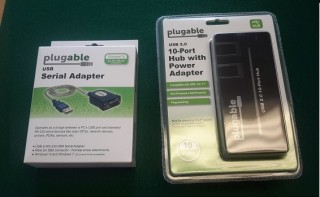To connect a serial stream in SNIP see the article: Adding Serial UART Data Streams
To understand issues with drivers, see the article: Problems with USB / Serial Drivers
To understand and connect all the physical cables needed, read on… This article covers a few products and best practices on how to build up a collection of serial ports drivers and USB converts on other windows and *nix systems. The primary goal is to address the readers need to know how to “hook things up” without much support time so they can avoid spending time in “cable and driver hell” when things do not work.
USB Adapters, USB Hubs
There are many sources one can use for serial convertors. Your favorite electronics supplier will have many to select from. Here are two that have always proven themselves to SCSC over the years on both Windows and Unix systems, as well as for a number of embedded device projects implemented on various popular ARM processors board including Panda, Beagle Bone Black, and Dragon board.
The specific part descriptions in the above are:
- Plugable USB to RS-232 DB9 Serial Adapter (Prolific PL2303HX Rev D Chipset)
- Plugable USB 2.0 10-Port High Speed Hub with 12.5W Power Adapter and Two Flip-Up Ports
Hint: In the Windows OS, each and every time you plug in a new serial to USB device, Windows will assign it a driver and then “helpfully” assign a new (and probably unique) port number to it. Even if you plug in another copy of the the exact same model device, you will get another new comm port number assigned. That is why on some of our SNIP screen shots you will see comm ports numbered in the 50’s and well above,as we do this sort of swapping quite a bit. You cannot easily avoid this, but you can reduce the number of different ports you have to work with by associating the same set of USB cables with a given PC, or with a given GNSS device. Our recommended best practice is to keep the cable set with the GNSS device. Then, as a practical example, uBlox unit number X will always appear as port X on your machine and port Y on your coworker’s machine. In the SNIP serial port setup logic, it will only show you the actual serial ports you currently have loaded (plugged in) and will link that port (and other settings) to any serial caster slot you used it for the last time you set things up.
Cables Cables Everywhere, but which one do I need?
The variety of USB cable used with GNSS devices can be quite confusing. Here at SCSC we keep a handy visual cheat sheet next to the bins where such cables are kept. And still we often have to scramble to put the right cable set together. Below are two very good links, with pictures you might want to print, that serve to explain the USB plug maze.
 Wikipedia
Wikipedia
https://en.wikipedia.org/wiki/USB
L-Com, also a trusted source for any RF cabling needs you have
http://www.l-com.com/content/Article.aspx?Type=N&ID=628
Sparkfun also has good educational links with pictures at:
https://www.sparkfun.com/pages/USB_Guide
Level Shifters and FDTI
For those folks that like to touch the bare hardware we get the same question regarding what FDTI product to use on OEM boards to get a serial to USB driver back out. Same basic answer; look online and you will see many solutions to chose from. For what it is worth, when we need an actual USB cable (rather than a breadboard) we often use a brand called GearMo. GearMo offers USB to 3.3v TTL FTDI products and also USB to 5v TTL FTDI products and you must be sure what levels you will be translating from to order the right part.

